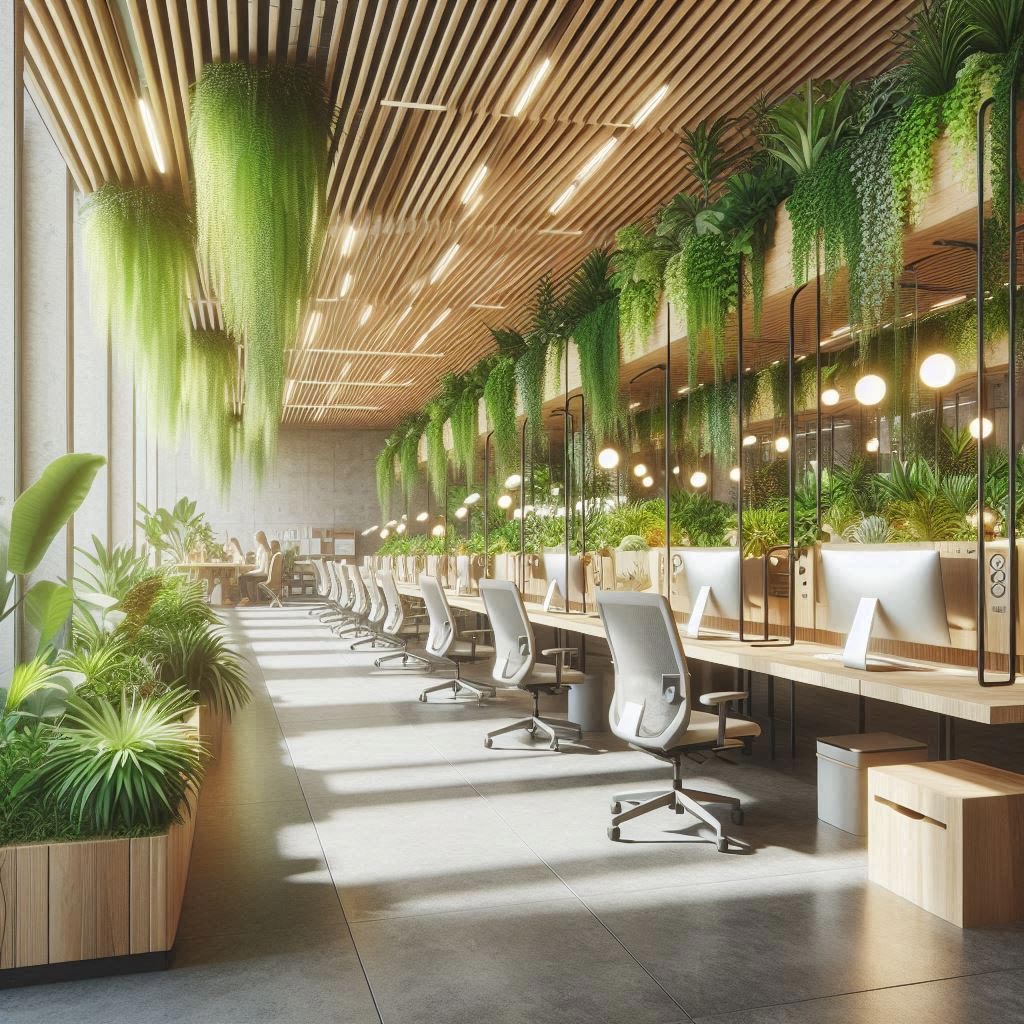As awareness of the environmental impact of human activities continues to grow, it is increasingly important to find ways to reduce our carbon footprint and minimize waste both at home and in the workplace. Sustainable workspaces have become a critical focus for companies aiming to create efficient, productive, and environmentally responsible environments. The International Energy Agency (IEA) reports that the industry and buildings sectors, including offices, accounted for approximately 37% of global energy-related CO2 emissions in 2023. With many businesses returning to full-time office operations post-pandemic, sustainable office design has emerged as a top priority in 2024.
Why Sustainable Workspaces Matter
Sustainable workspaces prioritize reducing environmental impact, conserving resources, and promoting employee health and well-being. The benefits include:
- Environmental Impact Reduction: Sustainable design practices reduce waste, lower energy consumption, and encourage the use of renewable resources.
- Cost Savings: Energy-efficient systems and sustainable materials can lead to substantial cost savings over time.
- Improved Employee Health: Enhanced indoor air quality, natural lighting, and ergonomic design create a healthier work environment.
- Enhanced Productivity: A thoughtfully designed, sustainable workspace can improve employee morale, engagement, and productivity.
- Corporate Responsibility: Adopting sustainability demonstrates a commitment to corporate social responsibility, which can improve brand reputation and attract top talent.
Key Strategies for Designing Sustainable Workspaces
1. Energy Efficiency
LED Lighting: Switching to LED lighting is a straightforward and effective way to boost energy efficiency. LED bulbs use significantly less energy than traditional incandescent or fluorescent bulbs and have a much longer lifespan.
Smart Lighting Systems: Implement smart lighting systems that adjust based on occupancy and natural light levels. Motion sensors and daylight harvesting systems can greatly reduce energy consumption by ensuring lights are only used when needed.
Energy-Efficient Appliances: Select office equipment and appliances with high energy efficiency ratings. Look for ENERGY STAR-certified products, which adhere to strict energy efficiency guidelines set by the U.S. Environmental Protection Agency.
2. Sustainable Materials
Recycled and Reclaimed Materials: Use recycled content in building materials and opt for reclaimed furniture. These materials decrease the demand for virgin resources and reduce waste. Examples include recycled steel, reclaimed wood, and recycled glass.
Low VOC Materials: Volatile Organic Compounds (VOCs) are harmful chemicals found in many paints, adhesives, and finishes. Choosing low VOC materials helps improve indoor air quality and create a healthier work environment.
Sustainable Flooring: Eco-friendly flooring options such as bamboo, cork, and recycled carpet tiles are excellent choices. These materials are renewable, biodegradable, and have a lower environmental impact compared to traditional flooring options.
3. Indoor Air Quality
Ventilation Systems: Advanced HVAC systems that improve air circulation and filter out pollutants are essential for maintaining good indoor air quality. Regular maintenance of these systems is crucial to ensure they operate efficiently.
Plants: Incorporating biophilic design elements like indoor plants can significantly enhance air quality. Plants naturally filter air pollutants and increase oxygen levels, creating a more pleasant and healthier workspace.
Air Quality Monitors: Use air quality monitoring devices to track indoor air conditions. These devices provide real-time data, allowing for timely interventions to maintain optimal air quality.
4. Water Conservation
Low-Flow Fixtures: Install low-flow faucets, toilets, and urinals to reduce water consumption. These fixtures are designed to use significantly less water without compromising performance.
Water Recycling Systems: Implement systems to recycle greywater for non-potable uses such as irrigation and toilet flushing. Greywater recycling can drastically reduce water usage and contribute to sustainability goals.
Smart Irrigation: For offices with outdoor landscaping, smart irrigation systems optimize water usage by adjusting watering schedules based on weather conditions and soil moisture levels.
5. Waste Reduction
Recycling Programs: Establish comprehensive recycling programs for paper, plastic, glass, and electronic waste. Educate employees on proper recycling practices and provide easily accessible recycling bins.
Composting: Provide composting options for organic waste in kitchen and dining areas. Composting reduces the amount of waste sent to landfills and can be used to enrich soil in landscaping projects.
Digital Solutions: Promote a paperless office by using digital document management systems. Encourage electronic communication and reduce reliance on printed materials.
6. Sustainable Furniture
Modular Furniture: Choose modular and flexible furniture that can be easily reconfigured or upgraded. Modular furniture extends the lifespan of office furniture and reduces waste.
Certified Sustainable Products: Select furniture and furnishings certified by sustainability standards such as GREENGUARD or FSC (Forest Stewardship Council). These certifications ensure products meet rigorous environmental and health criteria.
7. Green Building Certifications
LEED Certification: LEED (Leadership in Energy and Environmental Design) certification is a globally recognized standard for green building design. Aim for LEED certification by meeting stringent environmental and sustainability criteria.
WELL Certification: WELL certification focuses on the health and well-being of building occupants. Pursue WELL certification to ensure your workspace promotes physical and mental health through design, operational policies, and organizational culture.
8. Smart Technology Integration
IoT Devices: Utilize Internet of Things (IoT) devices for energy management, lighting control, and building automation. IoT devices provide real-time data and analytics to optimize building performance.
Remote Work Infrastructure: Support remote work capabilities to reduce commuting and the associated carbon footprint. Invest in robust digital infrastructure to facilitate seamless remote collaboration.
Energy Management Systems: Implement energy management systems to monitor and optimize energy usage in real-time. These systems help identify inefficiencies and provide actionable insights for energy conservation.
9. Employee Well-Being
Natural Light: Maximize natural light through strategic placement of windows, skylights, and glass partitions. Natural light has been shown to improve mood, energy levels, and productivity.
Ergonomic Design: Provide ergonomic furniture and workstations to enhance comfort and productivity. Adjustable chairs, sit-stand desks, and ergonomic accessories can prevent musculoskeletal issues and promote well-being.
Healthy Work Environment: Encourage a healthy work-life balance with wellness programs, fitness facilities, and mindfulness spaces. Offering access to fitness classes, mental health resources, and relaxation areas can improve overall employee well-being.
10. Sustainable Transportation
Bike Facilities: Provide bike racks, showers, and changing rooms to encourage cycling to work. Promoting cycling reduces the carbon footprint associated with commuting and supports employee health.
Electric Vehicle Charging Stations: Install EV charging stations to support the use of electric vehicles. Offering charging infrastructure can incentivize employees to choose environmentally friendly transportation options.
Public Transport Incentives: Offer incentives for employees to use public transportation or carpooling. Subsidizing public transport passes or providing carpooling benefits can reduce the environmental impact of commuting.
Implementing Sustainable Practices: A Step-By-Step Guide
Step 1: Assess Current Sustainability Practices Conduct a comprehensive assessment of your current sustainability practices. Identify areas where improvements can be made and set measurable goals for enhancing sustainability.
Step 2: Engage Stakeholders Involve key stakeholders, including employees, management, and external partners, in the planning process. Collaboration ensures that sustainability initiatives are aligned with organizational goals and receive broad support.
Step 3: Develop a Sustainability Plan Create a detailed sustainability plan outlining specific initiatives, timelines, and responsible parties. The plan should include short-term and long-term goals, as well as metrics for tracking progress.
Step 4: Educate and Train Employees Educate employees about the importance of sustainability and provide training on new practices and technologies. Encourage a culture of sustainability by recognizing and rewarding efforts to promote environmental responsibility.
Step 5: Implement Sustainable Practices Begin implementing sustainable practices according to the plan. Prioritize initiatives that offer the greatest environmental impact and cost savings. Regularly review progress and make adjustments as needed.
Step 6: Monitor and Report Progress Use data and analytics to monitor the effectiveness of sustainability initiatives. Regularly report progress to stakeholders and celebrate milestones to maintain momentum and support.
Step 7: Continuously Improve Sustainability is an ongoing process. Continuously seek opportunities for improvement and stay informed about new technologies and best practices. Encourage innovation and adaptability to achieve long-term sustainability goals.
Conclusion
Designing sustainable workspaces in 2024 requires a comprehensive approach that integrates energy efficiency, sustainable materials, indoor air quality, water conservation, waste reduction, sustainable furniture, green building certifications, smart technology, employee well-being, and sustainable transportation. By implementing these strategies and following a structured plan, businesses can create work environments that are not only environmentally responsible but also conducive to employee health, well-being, and productivity.
Embracing sustainability in office design is more than a trend—it’s a necessary step towards a more sustainable and prosperous future. As we move forward, the commitment to creating sustainable workspaces will play a crucial role in shaping a better world for generations to come.

